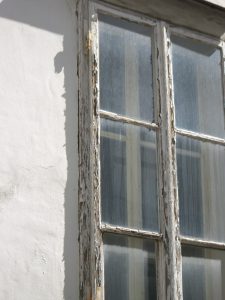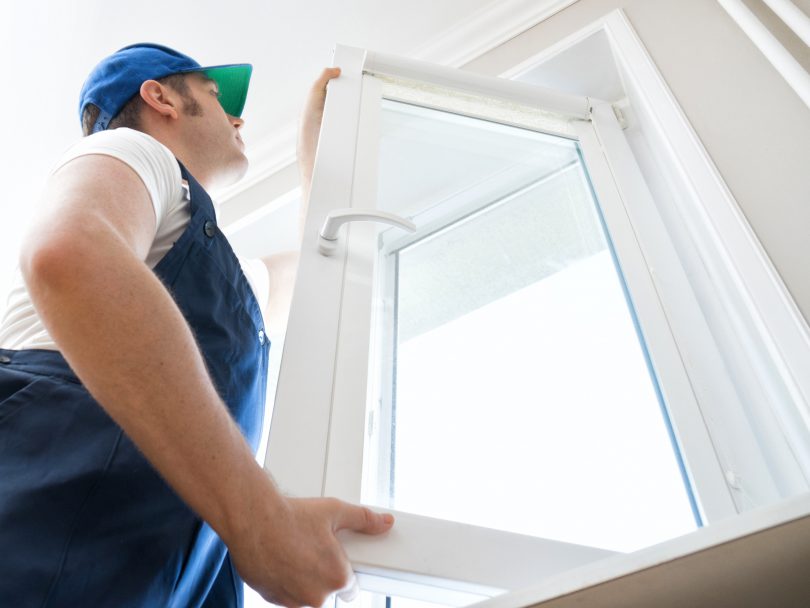By Pat Keegan and Brad Thiessen
If your home’s windows are very old and you feel the chill when you stand near them when the weather is cold, you may want to consider replacing them. However, prepare yourself for a bit of sticker shock when you get your first bid. To help you decide if replacement is the right move, you’ll want to consider a few factors.
Increased Comfort
The chill you feel near your windows when it is cold out is likely due to radiant heat loss. When you’re near a cold surface, such as a window, you can feel chilled even if the temperature inside your home is more than 70 degrees. Your body is much warmer than the surface of the window, and heat radiates from warm to cold. The inside surface of an inefficient, single-pane window will be much colder on a winter night than that of a double- or triple-pane window.

Curtains can be an affordable strategy to increase comfort and reduce energy use. Photo Source: Scott Van Osdol
Window coverings are one approach to increasing the comfort level of your home. Curtains and blinds are very effective at reducing radiant heat loss in the winter and can even block some unwanted heat gain in the summer.
Another aspect to comfort is the sun. If you have cold winters but lots of winter sunshine, you might enjoy the comfort and warmth of the sun streaming through your windows on a cold clear day. If that’s the case, take it into consideration as you ponder window replacement. Some windows are better at letting the sun’s heat into the home than others.

Old wood windows may be worth sanding and repainting, and can sometimes be retrofitted with more efficient glass. Photo Credit: Mike Scoltock
Appearance and Function
If your windows are older, new wood- or vinyl-framed windows can act as an exterior facelift. Keep in mind, however, if you own an older home with classic wooden windows, vinyl replacements might look out of place. It’s possible to buy new windows that match the style of some older wooden windows, or you could decide to apply a little elbow grease to get them back into shape. Wooden windows, even if they were built before 1960, can last the life of the home.
Windows can provide ventilation, which sometimes improves comfort more cost-effectively than air conditioning. Windows also need to be cleaned occasionally. If your existing windows don’t provide ventilation or they are hard to clean, replacing them could solve these problems.
Resale Value
Windows are a major point of interest for most prospective homebuyers, which is why we often hear that window replacement is good for resale value. But a 2019 study by the National Association of Realtors found that, on average across the U.S., installing new vinyl windows costs about $22,000 per home but only increased resale value by $16,500. Only 4% of realtors said the new windows helped close the sale, so if resale value is your main objective, the costs could likely outweigh the return on investment.
Energy Savings
Homeowners often believe that the best way to reduce energy use is to replace their windows, but this is rarely true. Companies that sell new windows sometimes advertise greater energy savings than the new windows can actually deliver. The amount of energy you save really depends on the efficiency of your existing windows compared to the efficiency of the replacement windows. An energy auditor can estimate potential savings, but most audits show that there are much more cost-effective efficiency investments than replacing windows.
On average, according to ENERGY STAR, replacing single-pane windows in a 2,000 square-foot home with ENERGY STAR-certified windows will produce an average savings of $125 to $340 per year, depending on where you live. At this rate, it would take a decade or more to pay off your initial investment.
Replacing old windows can provide a number of benefits, but it’s a costly endeavor. By considering these factors and how long you plan to live in the home, you can make the right decision. Next month we’ll provide information that will help you decide what to look for in a replacement window.
This column was co-written by Pat Keegan and Brad Thiessen of Collaborative Efficiency.

